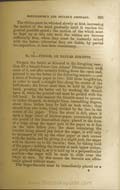Prepare the batter as directed in the foregoing case; then fill a biscuit-forcer (sec Adams' Illustrations) with some of it, and after securely folding down the open end, proceed to use the batter in the following manner:—cut a sheet of foolscap paper in two; fold these lengthwise, in order to mark a straight line along the centre of the half-sheets; the forcer must then be held in the right hand, pressing the batter out by working the thumb upon it, while the pointed end must be guided with the left hand. In this manner the biscuits must be spread, or rather dropped, in straight lines, resembling fingers, about three inches long by half an inch wide; they should form two rows, being divided by the line in the centre of the paper. When the sheet is full, place it upon a large sheet of kitchen-paper, containing about one pound of the finest-sifted sugar, placed in the form of a ridge along the upper part of the paper as it lies on the table before you; the sheet containing the biscuits being placed just below the sugar, it will only be necessary to lift up the other paper at each corner with the hands, and by giving it a slight jerk, the sugar will be thrown on to the biscuits; then, by taking hold of the paper—holding the biscuits at each upper corner, and gently shaking it, as it is held up in a perpendicular position—the sugar will be made to slide over the whole at once. By this means the biscuits are effectually glazed without waste.
The finger-biscuits must be immediately placed on a baking-sheet, and put in the oven (at very moderate heat); about a quarter of an hour will suffice to bake them. When done, they should be of a very liglit-yellow colour.
Note.—With the same kind of batter, and by using a biscuit-forcer, the shape of these small biscuits may be easily varied according to taste or fancy. These biscuit-forcers are also made of tin, resembling the point of a funnel in shape: they have a bag of wash-leather, or canvas cloth, affixed round the upper part, with a string running through the top, which, when the bag is filled with batter, is drawn tight; thus effectually preventing it from escaping at the upper end while it is forced out at the point below. The use of this utensil, however, is objectionable, from the leather or canvas contracting a nauseous odour. In other respects, it answers the purpose well enough (see Adams' Illustrations).
